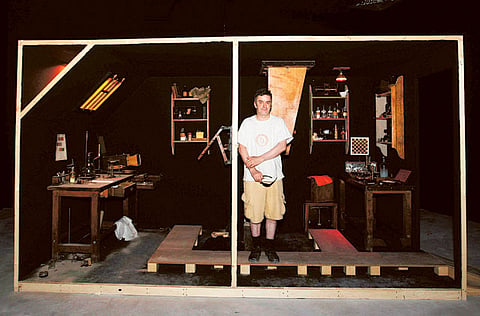Museum of Optography to open in Sharjah
Museum of Optography a tribute to last imprinted image on retina, at moment of death

Sharjah: The workings of a human eye has been likened to that of a camera and vice versa, but the major difference was that the images our eyes capture are fleeting and temporary. But this is where optography comes in.
Optography is a method for extracting and temporarily “fixing” the last imprinted image on the retina, at the moment of death. The first and only known human optogram, was created by Wilhelm Kühne, a German physiologist in the 19th century, who happens to be the central character on which Derek Ogbourne built his “Museum of Optography.”
Derek Ogbourne is a London-based artist who has been fascinated by eyes and mortality, after he was punched in the eye at a party in the 90s, which later led him into optography. He took that obscure idea by Kühne and created around it some 300 works, ranging from drawings, recreations of the objects possibly used for optography, videos, installations, as well as two catalogues and an encyclopaedia.
“I have taken a little event that happened in the 19th century, so tiny so forgotten, so in the subconscious and I have blown it into this massive thing.” Ogbourne said. He was referring to the only human optogram, which Kühne obtained and sketched from the eye of Gustav Erhard Reif, a man who was beheaded for killing his two sons in the Rein river in the late 1870s.
Gulf News was given an exclusive pre-opening tour of his “Museum of Optography -The Purple Chamber”, the latest instalment of his on going “Museum of Optography”. The museum will be opened to the public on Sunday and will run until October 3 at the Collections Building, Arts Area, Heart of Sharjah opposite Sharjah Museum of Art.
Recreating history
Ogbourne said some items on exhibit may seem to look like a historical fact, but on the contrary, it’s not. “The idea is that you should be not quiet sure what is what. I am inventing and recreating history”.
He said he had never made an optogram, but he imagines what those last images were. “I love animals too much to just kill them.” he said. “The process of making an optogram is by blindfolding the person, rabbit or frog. Generally, rabbits and frogs are best as their eyes contain more rhodopsin or visual purple, which is the light sensitive protein in the retina. You leave them for 10 minutes so their eyes get dark adapted. Then you set them up in front of an image; the image has to be very contrasting, very black and white. Then you uncover their eyes and let them stare at it for 10 minutes, then you kill them and then as you do that you place them under an orange light, so the image wouldn’t fade from the light, and then you place the retina in alum, which preserves the image and makes the retina easy to handle and you can see the optogram.” Ogbourne explained.
Optogram appears as a white image on a red or purple background. Unlike a photographic negative the light and dark areas are not reversed.
Manipulated sketches
The museum, which is Ogbourne’s sixth, is part science, part fiction, part history but all art. It includes exhibits such as a very detailed recreation of what he imagines Kuhne’s laboratory looked like, photos of rabbit optograms from 1975, various anatomically accurate sketches of eyes that have been manipulated to include small humanoids and many other exhibits that relate to eyes and the moments before death.
One of the most interesting exhibits is a wall made of 145 detailed “imagined last moments” drawn by Ogbourne, that have to be viewed with a magnifying glass, conveniently hung next to the artwork. The rabbit optograms, Ogbourne told Gulf News, were made by Evangelos Alexandridis, a German scientist, who was approached by the police and asked if he could create optograms to help them solve a case after they read about Kuhne’s original experiments. There is a documentary that shows Alexandridis explaining how he did the experiments.
“Optograms are hard to obtain from humans because the human eye does not have that much visual purple. It is more in animals who live at night like frogs and rabbits,” Ogbourne said. He added that a good description of an optogram is that when you lean up against an object and you get that imprint on your skin, “it is not what you are thinking, it is not necessarily what you are seeing, but what your retina is receiving even if you were daydreaming.”
Sign up for the Daily Briefing
Get the latest news and updates straight to your inbox


